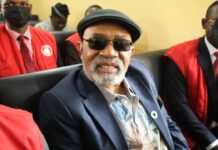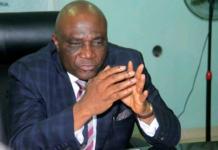Lukman Omikunle
In Nigeria, millions of people across 35 states have been affected by the flooding, causing extreme destruction in the country
LAFIA, Nigeria, November 8, 2022/ — The torrent of water swept through Angulu Village, in Doma Local Government Area, Nasarawa State, displacing thousands of people and inundating dozens of buildings, including the health facility serving the community.
With a swollen belly and aching feet, eight months pregnant Abiye Bawa, and her family, fled her community on a boat in September 2022 to seek refuge in the highlands.
The 25-year-old, who now calls the Internally Displaced Person camp at Rukubi, Nasarawa State home, recently gave birth at the health facility close to the camp.
She also relies on the health care services provided at the IDP camp and a health care centre at Rukubi for health intervention.
Mrs Bawa said “I am not happy I gave birth to my child in this situation and wish I could provide a better place. The house we live in now is overcrowded, as there are so many people. Almost 100 people live in a small space.
“The flooding has made my livelihood hard for me and my family. It has not been easy and we are falling ill and fatigued due to starvation. I was into farming because the occupation of the people in my community was farming and hunting.
The water level started rising gradually in August. At first, we will not perturb, but when some children and adults began to disappear and the family lands flooded, we decided to move to higher grounds,” she said.
In Nigeria, millions of people across 35 states have been affected by the flooding, causing extreme destruction in the country.
On ground support
The damage to health infrastructures is disrupting health services and many pregnant women like Mrs Bawa, now live in camps for the displaced and need urgent care. In Nasarawa state, 11 of the 13 Local Government Areas (LGAs) in the state are affected and 11 health facilities previously serving a catchment population of 17401 are either partially (4)or completely (8) flooded.
Significant public health threats include the spread of water- and vector-borne diseases, with outbreaks of diarrheal diseases, skin infections, respiratory tract infections, malaria, and snake bites among others.
To cushion the effect of the flood on the health of the displaced persons, the Nasarawa State government and the World Health Organization (WHO), have been providing health care in many of the displacement camps with particular support to children, and pregnant and lactating mothers.
Allaying concerns about health care services among flood-displaced persons in Nasarawa State, WHO delivered supplies needed by health facilities and increased disease monitoring to prevent the spread of infectious diseases.
Appreciating the government, WHO and partners for the succour, Mrs Bawa said, “It has not been easy, by the government and the WHO have been of great support.
“They came to our aid by assessing the situation and sensitized us on how to protect ourselves from communicable diseases. We were given some tablets that we can use to purify our water and other materials to disinfect our environment.
For my child, I will ensure I go to the health facility for her immunization. We are also using the insecticide-treated nets,” she said.
Emergency aid
In response to the situation in the state, Mr Ibrahim Ahmed, Director of Planning, Nasarawa State Emergency Management Agency, said the flood has displaced 145 000 people from 95 communities (settlements)in 11 LGAs in the state.
Mr Ahmed said the government with support from partners like WHO has been adopting various innovative interventions to mitigate the situation among the people and ensure they have access to quality health services.
He said access to health services has stopped because most of the health facilities are also affected by floods. Many communities are submerged and the members of the communities have to take refuge on higher grounds where they make a shift shelter exposing them to environmental hazards, such as cold, mosquitoes and other communicable diseases.
“The source of water (open well) is also compromised, which can lead to a cholera outbreak because open defecation is still being practised in the communities. With the support of WHO, the state is mapping and linking the affected communities to health facilities closer to them in their displaced area”, he said.
Intervention
To aid the government’s emergency response, WHO is coordinating the stakeholders’ meeting to carry out situation analysis and review the intervention carried out.
The WHO Nasarawa State Coordinator, Dr Lawrence Ohammah said WHO has trained IDP focal persons on priority disease detection, reporting and WASH to notify and prevent diseases outbreak in the camps.
In line with the government’s relief plan, WHO has trained health workers on cholera case management and infection prevention control measures, deployed 65 rapid response team members and distributed 2600 medical supply packages that include supplies to manage cholera.
SOURCE:
World Health Organization (WHO) – Nigeria




























![The Statesman’s Return — OGD in the Senate and the Rebirth of Strategic National Leadership [Part 5]](https://newsheadline247.com/wp-content/uploads/2024/07/Gbenga-Daniel-newsheadline247_1-324x160.jpeg)